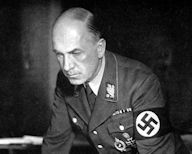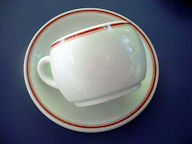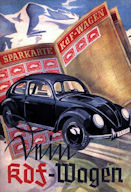|
|
|
|
Kraft durch Freude
(Strength through Joy)
Page 1
|
|
|
Important Medallion Commemorating the Norwegian Voyage of the KDF Ship Robert Ley (Item JOY 1-1) |
| DESCRIPTION: Robert Ley was a cruise ship of the National Socialist Party leisure organization Kraft durch Freude (KdF) (Strength Through Joy). It was considered the flagship of the KdF fleet. The ship was named after the Nazi politician Robert Ley and was designed exclusively for cruises. The keel was laid on behalf of the Nazi organization Deutsche Arbeitsfront (DAF) (German Labor Front) at Howaldtswerke-Deutsche Werft, Hamburg. Robert Ley was owned by the DAF and was managed, crewed, and maintained by the Hamburg-Amerikanische Packetfahrt-Actien-Gesellscharft (HAPAG). The interior design was commissioned by architect Woldemar Brinkmann. The launch took place in 29 March 1938, in the presence of Adolf Hitler. The commissioning took place on 24 March 1939. The ship was designed for about 1,750 passengers in addition to the crew. The KdF was originally set up by party leader, Dr. Robert Ley, as a promotion tool to forward and present advantages to the workers of Germany (“The People!”). It soon became the world’s largest tourism operator of the 1930s. KdF was meant to bridge the class divide by making middle-class leisure activities available to the masses. This was underscored by having cruises with passengers of mixed classes and having them, regardless of social status, draw lots for allocation of cabins. A somewhat less ideological goal was to boost the Germany economy by stimulating the tourist industry out of its slump for the 1920s. It was quite successful up until the outbreak of World War II. By 1934, over two million Germans had participated on a KdF trip; by 1939 the reported numbers lay around 25 million. With the outbreak of war in 1939, the organization unfortunately was mothballed, and several projects, such as the massive Prora beach resort, were never completed. Dr. Robert Ley (15 February 1890-25 October 1945) Dr. Ley was an important German political leader during the National Socialist era and headed the German Labor Front from 1933 to 1945. He was born in Niederbreidenbach in the Rhine Province, the seventh of 11 children of a heavily indebted farmer, Friedrich Ley, and his wife Emilie (née Wald). He studied chemistry at the universities of Jena, Bonn, and Münster. He volunteered for the army at the outbreak of World War I in 1914, and spent two years in the artillery before training as an aerial artillery spotter with Field Artillery Detachment 202. In July 1917, his aircraft was shot down over France and he was taken prisoner. After the war Ley returned to university, gaining a doctorate in 1920. Later enraged by the French occupation of the Ruhr in 1924, Ley became an ultranationalist and joined the Nazi Party soon after reading Adolf Hitler’s speech at his trial following the Beer Hall Putsch in Munich. By 1925, he was Gauleiter of the Southern Rhineland district and editor of an anti-Semitic Nazi newspaper, the Westdeutsche Beobachter. Ley proceeded with unswerving loyalty to Hitler for the rest of his life. In 1931, he went to the Nazi Party’s Munich headquarters to take over as head of the party organization following Hitler’s dismissal of Gregor Strasser in an internal dispute. Ley’s impoverished upbringing and his experience as head of the largely working-class Ruhr party region meant that he was sympathetic to those elements in the party who were open to socialism, which Hitler opposed, but he always sided with Hitler on inner-party disputes. When Hitler became chancellor in January 1933, Ley accompanied him to Berlin. In April, when the trade union movement was taken over by the state, Hitler appointed him head of the German Labor Front (Deutsche Arbeitsfront- DAF). The DAF took over the existing Nazi trade unions and made the NS government the final champion of the workers while always respecting the position of management as well in all labor disputes. A more industrious worker in all that he did can hardly be imagined, and it certainly cannot be denied that he worked diligently for the socialist betterment of Germany and its Führer and workers. The Medallion The KdF cruise planners always seemed to favor Norway and its awesome fjords for many of the trip destinations and this beautiful medallion depicts the bow of Robert Ley emerging from the Reich that is depicted as a swastika and it says: “NORWEGENFAHRT DER DEUTSCHEN TECHNIK– 10-16. V. 1939” (Norwegian Journey of German Technics). On the reverse side, there is the N.S. eagle and swastika and under this is the legend: “IHREM GROSSEN SOHN PROF. DR. ING. F. TODT SEINE VATERSTADT PFORZHEIM.” (Our great son Professor Doctor Engineer F. Todt from your home city Pforzheim.) Dr. Fritz Todt (4 September 1891-8 February 1942) Dr. Todt was a great German construction engineer, and senior National Socialist figure, who rose from “inspector General for German Roadways” where he oversaw the construction of German Autobahnen (Reich autobahn) and later to Reich Minister for Armaments and Ammunition where he led the entire war military economy. At the beginning of World War II he founded what Hitler named Organization Todt, a military engineering company which supplied industry with labor and administered all constructions within Germany during the late phase of the Third Reich. He died in a plane crash in 1942 and was succeeded by Albert Speer in all of his offices and duties. The medallion is indeed a significant piece of important history of the former great workers’ Reich. Now it remains possibly as a reminder to us that contrary to the talking heads on TV like Sean Hannity and Mark Levin, who have consistently uttered the old canard that Socialism has ‘never worked’ in the world wherever it was tried. Well, they are wrong, wrong, wrong! Because In National Socialist Germany it not only worked, but also most definitely prospered! No better system for the citizens of any nation has ever existed in this world! The medallion is about 1¼ inches in diameter—small but it certainly packs a very significant history! PRICE: $295.00; one of the most important pieces we have ever offered |
|
|
Coffee Cup and Saucer Set from Kraft durch Freude--KdF (Strength through Joy) section of the DAF(20) (Item MESSHALLPORC 1-20; JOY 1-3) |
| DESCRIPTION: The German Labor Front (Deutsche Arbeitsfront [DAF]) was the National Socialist labor organization which replaced the various independent trade unions in Germany after Adolf Hitler's rise to power. Its leader was Robert Ley, who stated that its aim was “to create a true social and productive community.” Theoretically, the DAF existed to act as a medium through which workers and owners could mutually represent their interests; wages were set by the 12 DAF trustees. The employees were given relatively high set wages and security of employment, and dismissal was increasingly made difficult. Social security and leisure programs were started, canteens, breaks, and regular working times were established, and German workers were generally satisfied by what the DAF gave them in repayment for their absolute loyalty. Following the National Socialist’s Volksgemeinschaft approach towards developing a greater "people's community,” the DAF expanded or established new social, educational, sports, health, and entertainment programs for German workers via the Strength through Joy program, which included factory libraries and gardens, swimming pools, low-priced hot meals, adult education programs, periodic work breaks, physical education, sports facilities, gymnastic training, orchestral music during lunch breaks, free tickets to concerts and opera, and subsidized vacations that saw over 10.3 million Germans signed up by 1938. The DAF financed the building of ocean-going vessels that permitted German workers to pay minimal prices to sail to many foreign destinations. Up to six ocean liners were operating just before the start of World War II. According to the chief of the Associated Press in Berlin, Louis P. Lochner, ticket prices for ocean-steamer vessels ranged from twelve to sixteen marks for "a full week on such a steamer.” For those who desired vacations closer to home, the DAF constructed spa and summer resort complexes. The most ambitious was the 4.5-km long Prora complex on Rugen island, which was to have 20,000 beds, and would have been the largest beach resort in the world. It was never completed and the massive complex largely remained an empty shell right through until the 21st century. The set of cup and saucer is complete with the pieces intact and in perfect condition; matching and they bear the company logos of the firm HUTSCHENREUTHER. This firm had its beginnings in1814 in Selb, Bavaria. Before and during WWII this company made most of the Wehrmacht mess hall porcelain tableware. The other mark on the piece seen under the glaze is the cogged wheel and swastika insignia of the DAF with the wording that translates to: “Insignia of the office of the beauty of work” (Schöenheit der Arbeit). The saucer measures 6 inches in diameter; the cup measures 2 1/2 inches high and about 4 1/2 inches wide to include the handle. To find an intact grouping of cup and saucer like this and so perfect is very rare and after all of 80 years is nothing short of incredible! As with all of the military mess hall porcelain the material used was called “ironstone” and is “iron tough.”
PRICE: Only the cups are available at $85.00 each |
Page One |
Please refer to item designator in parentheses in all correspondence.
Please E-mail for any additional information you may need.If you prefer, contact 'Germania' at PO Box 68, Lakemont, GA 30552
or call at 706.782.1668.
Please! do not call during the wee hours of the morning. The best time for calling us is between 9 and 11 am and between 9 and 11 pm eastern time.




















